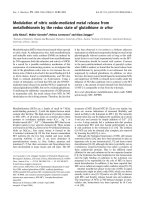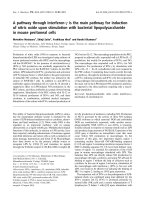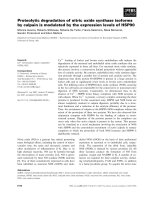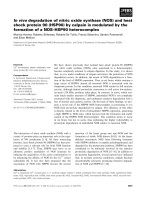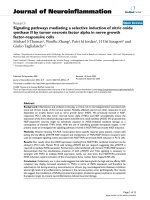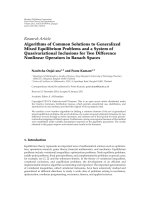Composite controlled release system of nitric oxide for cardiovascular tissue engineering application
Bạn đang xem bản rút gọn của tài liệu. Xem và tải ngay bản đầy đủ của tài liệu tại đây (5.57 MB, 210 trang )
COMPOSITE CONTROLLED RELEASE SYSTEM
OF NITRIC OXIDE FOR CARDIOVASCULAR
TISSUE ENGINEERING APPLICATION
ZHANG QINYUAN
NATIONAL UNIVERSITY OF SINGAPORE
2013
COMPOSITE CONTROLLED RELEASE SYSTEM
OF NITRIC OXIDE FOR CARDIOVASCULAR
TISSUE ENGINEERING APPLICATION
ZHANG QINYUAN
B.Eng. (Hons), National University of Singapore
A THESIS SUBMITTED FOR THE DEGREE OF
DOCTOR OF PHILOSOPHY
DEPARTMENT OF MECHANICAL ENGINEERING
NATIONAL UNIVERSITY OF SINGAPORE
2013
- i -
Declaration
I hereby declare that this thesis is my original work and it has been
written by me in its entirety. I have duly acknowledged all the sources of
information which have been used in the thesis.
This thesis has also not been submitted for any degree in any university
previously.
Zhang Qinyuan
25 September 2013
- ii -
Abstract
Current synthetic vascular grafts for the reconstructive bypass
surgeries face the problem of post-surgery restenosis. Localised sustained
release of nitric oxide (NO) is a promising strategy to prevent restenotic events
such as vascular smooth muscle cells (vSMCs) over-proliferation, and
promote the healing of injured endothelial layer. In this project, a composite
controlled release system of NO was developed as a potential material for
synthetic vascular grafts via the integration of NO-releasing nanoparticle,
hydrogel and polymeric film. A new NO-releasing gelatin-siloxane
nanoparticle (GS-NO NP) was developed via S-nitrosothiol modification with
good NO-releasing property and excellent cytocompatibility. The potential of
freeze-thawed poly(vinyl alcohol) (FT-PVA) hydrogels as carriers for GS-NO
NP was evaluated from their property changes with nanoparticle addition,
suggesting single FT-PVA hydrogel system might be suitable for applications
with moderate addition of GS-NO NPs to maintain their hydrogel properties.
GS-NO NP-doped PVA hydrogels were further integrated with biaxial
stretched poly(ε-caprolactone) films (µPCL) using electrospinning and
freezing-thawing (F/T) technique. The integrated composite release system of
NO (PCL/PVA/GS-NO) exhibited prolonged NO release for up to 40 days,
and enhanced mechanical properties as compared to single FT-PVA hydrogel
system, demonstrating the potential to be used for restenosis prevention and as
materials for synthetic vascular graft construction.
- iii -
Acknowledgements
The past few years of PhD study have been an unforgettable and
fruitful journey in my life that led me to a world full of exciting challenges
and amazing facts. It is even a greater fortune to me that there have been so
many people being supportive and accompanying me all along the way.
I would like to show my deepest gratitude to my supervisors, Assistant
Professor Thian Eng San, Professor Teoh Swee-Hin and Associate Professor
Li Jun. I would like to thank them for their teaching and guidance in scientific
thinking and writing, and their generous support whenever I encountered
difficulties in research work or in daily life. From their constant sharing of
knowledge and life experiences, I found not only inspirations in scientific
research, but also wisdoms of life. This work would not have been possible
without their supervision and support.
I would also like to give my appreciations to the past and present
colleagues and students from BIOMAT Lab and Supramolecular Biomaterials
Lab: Zuyong, Lim Jing, Mark, Erin, Yuchun, Zhiyong, Chang Lei, Poon Nian,
Ruey Na, Yi Min, Jason, Freddie, Wang Zhuo, Lan Ying, Chengde, Jingling,
Zhao Feng, Yuting, Song Xia, Xiaohong, Ping Yuan, and Yin Hui, for their
help and the pleasure of their company. My special thanks go to Dr Wen Feng
for his advice and constant support on the experimental work. I am also
Publications
- iv -
grateful to Zhao Jing, Tao Li, and Caolemeng for their friendship and kind
help in the experiments.
I would like to thank Ms Sharen Teo in Mechanical Engineering for
her kind assistance in the administrative stuff, and Mr Thomas Tan, Mr Hong
Wei Ng and Mr Khalim Abdul in Materials Lab for their help in the
experiments all these years.
Most importantly, I would like to give my heartfelt thanks to my
parents for their trust in my decisions, their cares and love shown in many
ways, and their encouragement and unwavering support to me especially
during my tough times. With love and gratitude, I dedicate this PhD thesis to
them. I also dedicate this PhD thesis to Mr Jinliang Yang, who was my mentor
and best friend that gave me the courage to begin this wonderful journey.
The work of this thesis was carried out in BIOMAT Lab and
Supramolecular Biomaterials Lab with the funding support from the Ministry
of Education, Singapore (R 265-000-300-112). I would like to thank National
University of Singapore for the research scholarship.
- v -
Table of Contents
Declaration i
Abstract ii
Acknowledgements iii
Table of Contents v
List of Figures ix
List of Tables xiii
List of Abbreviations xiv
Chapter 1 Introduction 1
1.1 Background 1
1.2 Objectives and Hypotheses 6
1.3 Scope 8
Chapter 2 Literature Review 9
2.1 Vascular System 9
2.2 Coronary Arteries 9
2.2.1 Structure and Composition 10
2.2.1.1 Endothelial Cells (ECs) 12
2.2.1.2 Vascular Smooth Muscle Cells (vSMCs) 13
2.2.2 Response to Injuries 14
2.2.3 Restenosis of Coronary Artery 16
2.2.3.1 Pathophysiology of Restenosis 16
2.2.3.2 Therapeutic Control of Restenosis 19
2.3 Vascular Tissue Engineering (VTE) 21
2.3.1 Acellular Approach 21
2.3.2 In vitro Tissue Engineered Blood Vessel (TEBV) 22
2.3.3 Cell Self-Assembled TEBV 23
2.3.4 Limitations of Current VTE Approaches 24
2.3.5 Composite Vascular Grafts 25
2.4 Nitric Oxide 27
2.4.1 Properties of NO 27
2.4.2 NO in Cardiovascular System 29
Table of Contents
- vi -
2.4.3 NO and Restenosis 31
2.4.4 NO Donors 31
2.4.4.1 Organic Nitrate/Nitrites 32
2.4.4.2 Iron-Nitrosyl Complexes 33
2.4.4.3 Sydnonimines 34
2.4.4.4 C-Nitroso Compounds 34
2.4.4.5 Diazeniumdiolates (NONOates) 35
2.4.4.6 S-Nitrosothiols (RSNOs) 36
2.4.5 Approaches for the Controlled Release of NO 37
2.4.5.1 NO-Releasing Polymeric Membranes 38
2.4.5.2 NO-Releasing Hydrogels/Xerogels 41
2.4.5.3 NO-Releasing Particles 44
2.4.6 Future Directions of NO-Releasing Materials 48
2.5 Materials and Fabrication Techniques 50
2.5.1 Materials 51
2.5.1.1 Gelatin-Siloxane Nanoparticles 51
2.5.1.2 Poly(vinyl alcohol) (PVA) 52
2.5.1.3 Poly(ε-caprolactone) (PCL) 54
2.5.2 Fabrication Techniques 56
2.5.2.1 Freezing-Thawing of PVA 56
2.5.2.2 Biaxial Stretching of Polymer Films 58
2.5.2.3 Electrospinning 60
Chapter 3 Synthesis of Nitric-Oxide-Releasing S-Nitrosothiol-Modified
Gelatin-Siloxane Nanoparticles 62
3.1 Introduction 62
3.2 Materials and Methods 64
3.2.1 Materials 64
3.2.2 Preparation of Gelatin-Siloxane Nanoparticles (GS NPs) 65
3.2.3 Preparation of RSNO-Modified GS NPs (GS-NO NPs) 65
3.2.4 Morphological Characterisation 67
3.2.4.1 Dynamic Light Scattering (DLS) 67
3.2.4.2 Field Emission Scanning Electron Microscopy (FESEM) 67
3.2.5 Composition Analysis 67
3.2.5.1 Fourier Transform Infrared Spectroscopy (FTIR) 67
3.2.5.2 Ultraviolet-Visible (UV-Vis) Spectrophotometry 68
3.2.5.3 Acid Orange 7 (AO7) Assay 68
3.2.5.4 Ellman’s Reaction 69
Table of Contents
- vii -
3.2.6 Release Kinetics of NO from GS-NO NPs 69
3.2.7 Cell Culture 71
3.2.8 AlamarBlue
®
Assay 71
3.2.9 Confocal Laser Scanning Microscopy (CLSM) 72
3.2.9.1 Fluorescent DAPI Cell Nucleus Staining 72
3.2.9.2 In Vitro Cellular Uptake of GS-NO NPs 72
3.2.10 WST-1 Assay 73
3.2.11 Data Analysis 73
3.3 Results 74
3.3.1 Synthesis of GS-NO NPs 74
3.3.2 Morphologies of GS and GS-NO NPs 74
3.3.3 Chemical Structure of GS-NO NPs 77
3.3.4 NO Release from GS-NO NPs 80
3.3.5 Cytotoxicity of GS-NO NPs 81
3.3.6 AoSMC Cellular Responses to GS-NO NPs 84
3.3.7 HUVEC Cellular Responses to GS-NO NPs 86
3.4 Discussion 87
3.5 Summary 94
Chapter 4 Properties of Physically Crosslinked Poly(vinyl alcohol)
Hydrogels with the Addition of Gelatin-Siloxane Nanoparticles 96
4.1 Introduction 96
4.2 Materials and Methods 98
4.2.1 Materials 98
4.2.2 Preparation of GS NPs 98
4.2.3 Preparation of FT-PVA/GS Hydrogels 98
4.2.4 Swelling Test 99
4.2.5 Mechanical Properties 100
4.2.5.1 Tensile Test 100
4.2.5.2 Compression Test 101
4.2.6 Differential Scanning Caloriometry (DSC) 102
4.2.7 Field Emission Scanning Electron Microscopy (FESEM) 102
4.2.8 Statistical Analysis 102
4.3 Results 103
4.3.1 Swelling Behaviour of FT-PVA/GS Hydrogels 103
4.3.2 Mechanical Properties of FT-PVA/GS Hydrogels 106
4.3.2.1 Tensile Properties 106
4.3.2.2 Compressive Properties 111
Table of Contents
- viii -
4.3.3 Crystallinity of FT-PVA/GS Hydrogels 116
4.3.4 Structural Properties of FT-PVA/GS Hydrogels 116
4.4 Discussion 119
4.5 Summary 126
Chapter 5 Development of a Composite Controlled Release System of
Nitric Oxide 128
5.1 Introduction 128
5.2 Materials and Methods 130
5.2.1 Materials 130
5.2.2 Preparation of µPCL Films 130
5.2.3 Preparation of µPCL Films with Electrospun PCL Fibres (cPCL)
131
5.2.4 Preparation of GS-NO NPs 131
5.2.5 Preparation of PCL/PVA/GS-NO Composites 131
5.2.6 Differential Scanning Caloriometry (DSC) 132
5.2.7 Water Contact Angle (WCA) 132
5.2.8 Morphological Characterisation 133
5.2.8.1 Field Emission Scanning Electron Microscopy (FESEM) 133
5.2.8.2 Confocal Laser Scanning Microscopy (CLSM) 133
5.2.9 Swelling Test 133
5.2.10 Tensile Test 134
5.2.11 Release Kinetics of NO from PCL/PVA/GS-NO Composites 134
5.2.12 Statistical Analysis 135
5.3 Results 135
5.3.1 Assembly of PCL/PVA/GS-NO Composites 135
5.3.2 Surface Hydrophilicity of PCL/PVA/GS-NO Composites 137
5.3.3 Morphological Properties of PCL/PVA/GS-NO Composites 138
5.3.4 Swelling Behaviour of PCL/PVA/GS-NO Composites 141
5.3.5 Mechanical Properties of PCL/PVA/GS-NO Composites 142
5.3.6 NO Release from PCL/PVA/GS-NO Composites 146
5.4 Discussion 147
5.5 Summary 152
Chapter 6 Conclusions 153
Chapter 7 Future Work 157
References 160
Appendix A - Publications 189
Appendix B - Awards 192
- ix -
List of Figures
Figure 1-1
Schematic illustration of the proposed work 6
Figure 2-1
Anatomy of the coronary arteries of the heart [41]……… . 10
Figure 2-2
Layered structure of a coronary artery [45]……………… . 11
Figure 2-3
Schematic of the basic physiological functions of nitric oxide
in the cardiovascular system (Blue arrows: inhibitive actions;
red arrow: promotive actions)……
. 30
Figure 2-4
Molecular structure PVA………………………………… . 53
Figure 2-5
Molecular structure PCL………………………………… . 54
Figure 2-6
Formation of 3D network structure in freeze-thawed PVA
hydrogels due to (a) hydrogen bonding, and (b)
microcrystallite formation [277].…………………………
. 57
Figure 2-7
Schematic of simultaneous biaxial stretching of polymer
films
. 59
Figure 2-8
Schematic of the electrospinning setup [301] . 60
Figure 3-1
DLS measurements of the size (a) and surface charge (b)
distribution of GS and GS-NO NPs………………………
. 76
Figure 3-2
Representative image of GS (a) and GS-NO (b) NPs (scale
bar = 1 µm)…………………………………………………
. 77
Figure 3-3
FTIR spectra of (a) GS NPs, (b) GS-SH NPs and (c) GS-NO
N
Ps…………………………………………………
. 79
Figure 3-4
UV-Vis spectra of (a) GS NPs and (b) GS-NO
N
Ps……
. 79
Figure 3-5
N
O release profiles from GS-NO NPs under physiological
conditions (pH 7.4, 37 °C) in the dark for 7 days (n =
3)……………………………………………………………
. 81
.
.
.
.
.
.
.
.
.
.
.
.
.
.
List of Figures
- x -
Figure 3-6
Cytotoxicity of GS and GS-NO NPs against L929 FBs as
measured using AlamarBlue® assay after (a) 1 day and (b) 7
days. Data were expressed as the percentage of control
(assigned 100 %), where control represents cells cultured in
the absence of NPs (n = 3)…………………………………
. 83
Figure 3-7
Proliferation of AoSMCs cultured with GS-NO NPs of
various concentrations for 7 days. Data were expressed as the
cell number countered from the CLSM images (n = 3; *** p
<0.001; ** p <0.01; * p <0.05)………………………
. 85
Figure 3-8
Cellular uptake of (a) GS and (b) GS-NO NPs in AoSMCs
after 2-h cell culture with the FITC-labelled NPs (Red
arrows: the NPs adhered on the cell membrane)…………
. 85
Figure 3-9
Proliferation of HUVECs cultured with GS-NO NPs of
various concentrations for 7 days. Data were expressed as the
p
ercentage of control (assigned 100 %), where control
represents cells cultured in the absence of GS-NO NPs (n =
3; * p <0.05)
. 87
Figure 4-1
Dynamic swelling of FT-PVA hydrogels subjected to (a) 1
F/T cycle, (b) 2 F/T cycles and (c) 4 F/T cycles in PBS at 37
°C for a total of 48 h (n = 3)
103
Figure 4-2
Dynamic swelling of FT-PVA and FT-PVA/GS hydrogels
subjected to (a) 1 F/T cycle, (b) 2 F/T cycles and (c) 4 F/T
cycles in PBS at 37 °C for a total of 48 h (n = 3)…………
105
Figure 4-3
Representative tensile stress-strain curves for (a) FT-PVA
and human coronary artery [348] (inset) and (b) FT-
PVA/125GS hydrogels subjected to various F/T cycles
107
Figure 4-4
Tensile modulus of FT-PVA and FT-PVA/GS hydrogels
subjected to different F/T cycles. The tensile modulus was
determined as the secant modulus at 40 % strain on the
stress-strain curve. * represents the significant difference as
compared to the tensile modulus of FT-PVA subjected to the
same F/T cycles (n = 4; *** p <0.001; ** p <0.01; * p
<0.05)
108
Figure 4-5
Tensile properties of FT-PVA and FT-PVA/GS hydrogels
subjected to different F/T cycles: (a) yield stress, (b) yield
strain, (c) ultimate stress and (d) ultimate strain. The ultimate
stress and strain were determined as the stress and strain at
fracture. * represents the significant difference as compared
to the value of FT-PVA subjected to the same F/T cycles (n =
4; *** p <0.001; ** p <0.01; * p <0.05)
110
.
.
.
.
List of Figures
- xi -
Figure 4-6
Representative compressive stress-strain curves for (a) FT-
PVA and (b) FT-PVA/125GS hydrogels subjected to various
F/T cycles
112
Figure 4-7
Compressive modulus of FT-PVA and FT-PVA/GS
hydrogels subjected to different F/T cycles. The compressive
modulus was determined as the tangent modulus at 40 %
strain on the stress-strain curve. * represents the significant
difference as compared to the compressive modulus of FT-
PVA subjected to the same F/T cycles (n = 4; ** p <0.01; * p
<0.05)
113
Figure 4-8
Compressive properties of FT-PVA and FT-PVA/GS
hydrogels subjected to different F/T cycles: (a) compressive
yield stress and (b) compressive yield strain. * represents the
significant difference as compared to the value of FT-PVA
subjected to the same F/T cycles (n = 4; *** p <0.001; ** p
<0.01; * p <0.05)
115
Figure 4-9
FESEM images of the fractured cross-sections of FT-PVA
and FT-PVA/GS hydrogels subjected to 2 and 4 F/T cycles
(scale bar = 10μm)
118
Figure 5-1
Representative DSC curve for (a) NaOH-treated µPCL, (b)
electrospun PCL fibres, (c) cPCL, (d) FT-PVA subjected to 2
F/T cycles and (e) PCL/PVA/5GS-NO subjected to 2 F/T
cycles
136
Figure 5-2
Change in the material surface hydrophilicity after each step
of the assembly (n = 3; *** p <0.001; * p <0.05)
137
Figure 5-3
FESEM images of (a) µPCL, (b) NaOH-treated µPCL, (c)
electrospun PCL fibres on cPCL, (d) cPCL, (e) PCL/PVA
without vacuum treatment and (f) PCL/PVA with vacuum
treatment. (Red arrows: the edge of the PVA layer penetrated
into PCL fibrous matrix; scale bar = 50 µm)
139
Figure 5-4
Morphology of PCL/PVA/GS-NO composites with different
GS-NO NP concentrations: (a, b) FESEM images of the
cross-sections of PCL/PVA/5GS-NO, (c, d) FESEM images
of the cross-sections of PCL/PVA/10GS-NO and (e) CLSM
image of the cross-section of hydrated PCL/PVA/5GS-NO
(Red arrows: GS-NO NPs; white arrows: electrospun PCL
fibres; scale bar = 100 μm for a and c, 10 μm for b and d, and
500 μm for e)
140
List of Figures
- xii -
Figure 5-5
Dynamic swelling of (a) PCL/PVA, (b) PCL/PVA/5GS-NO
and (c) PCL/PVA/10GS-NO composites subjected to 2 F/T
cycles in PBS at 37 °C for a total of 48 h (n = 3)
141
Figure 5-6
Representative tensile stress-strain curves for (a) NaOH-
treated µPCL, (b) electrospun PCL fibres, (c) cPCL, (d)
PCL/PVA, (e) PCL/PVA/5GS-NO and (f) PCL/PVA/10GS-
N
O
143
Figure 5-7
N
O release profiles from (a) PCL/PVA/5GS-NO composites
and (b) GS-NO NPs under physiological conditions (pH 7.4,
37 °C) in the dark. The cumulative NO release from
PCL/PVA/5GS-NO composites is averaged to the amount of
GS-NO NPs incorporated.
.
and
.
denote the half-life of
N
O release from PCL/PVA/5GS-NO and GS-NO NPs,
respectively (n = 3)
147
- xiii -
List of Tables
Table 3-1
Composition and characteristics of GS and GS-NO NPs
measured by DLS
. 76
Table 3-2
1
s
t
-order rate constants (k) and initial rates (I
R
) of NO release
from GS-NO NPs at 37 °C in the dark and from S-
nitrosoglutathione aqueous solution
. 81
Table 3-3
N
O release properties of GS-NO NPs and some reported NO-
releasing materials
. 90
Table 4-1
Crystallinity of FT-PVA and FT-PVA/GS hydrogels
experienced different F/T cycles
116
Table 5-1
Film mechanical properties after each step of the assembly
and theoretical burst pressure for PCL/PVA/GS-NO
composites (n = 4)
145
.
.
.
- xiv -
List of Abbreviations
µPCL Biaxial Stretched Poly(ε-caprolactone)
3D Three-Dimensional
AO7 Acid Orange 7
AoSMC Human Aortic Smooth Muscle Cell
APTMS 3-Aminopropyl-Trimethoxysilane
AuNP Gold Nanoparticle
BS Biaxial Stretching
BSA Bovine Serum Albumin
CABG Coronary Artery Bypass Graft Surgery
cGMP Cyclic Guanylate Monophosphate
CHD Coronary Heart Disease
CLSM Confocal Laser Scanning Microscopy
cPCL Biaxial Stretched Poly(ε-caprolactone) Films with
Electrospun Poly(ε-caprolactone) Fibres
CVD Cardiovascular Disease
DAPI 4',6-Diamidino-2-Phenylindole
DETA Dethylenetriamine
DI Deionised
DLS Dynamic Light Scattering
DMEM Dulbecco's Modified Eagle Medium
DS Degree of Swelling
DSC Differential Scanning Caloriometry
EC Endothelial Cell
ECM Extracellular Matrix
EDRF Endothelium-Derived Relaxing Factor
EGM Endothelial Growth Medium
ePTFE Expanded Polytetrafluoroethylene
F/T Freezing-Thawing
FB Fibroblast
FBS Fetal Bovine Serum
List of Abbreviations
- xv -
FESEM Field Emission Scanning Electron Microscopy
FITC Fluorescein Isothiocyanate
FTIR Fourier Transform Infrared Spectroscopy
FT-PVA Freeze-Thawed Poly(vinyl alcohol)
FT-PVA/GS Gelatin-Siloxane Nanoparticle-Doped Freeze-Thawed
Poly(vinyl alcohol)
GPTMS 3-Glycidoxypropyl-Trimethoxysilane
GS NP Gelatin-Siloxane Nanoparticle
GSNO S-Nitrosoglutathione
GS-NO NP S-Nitrosothiol-Modified Gelatin-Siloxane Nanoparticle
GS-SH NP Thiolated Gelatin-Siloxane Nanoparticle
HCl Hydrochloride
HUVEC Human Umbilical Vein Endothelial Cell
NADPH Nicotinamide Adenine Dinucleotide Phosphate-Oxidase
NaNO
2
Sodium Nitrite
NaNO
3
Sodium Nitrate
NaOH Sodium Hydroxide
NO Nitric Oxide
NONOate Diazeniumdiolate
NOS Nitric Oxide Synthases
NP Nanoparticle
PBS Phosphate Buffered Saline
PCI Percutaneous Coronary Intervention
PCL Poly(ε-caprolactone)
PCL/PVA/GS-NO Integrated Composite Controlled Release System of
Nitric Oxide
PDGF Platelet-Derived Growth Factor
PDI Polydispersity Index
PEG Poly(ethylene glycol)
PEI Poly(ethylenimine)
PEO Poly(ethylene oxide)
PGA Polyglycolic Acid
PLA Poly(lactic acid)
PLGA Poly(lactic-co-glycolic acid)
PMMA Poly(methyl methacrylate)
List of Abbreviations
- xvi -
PNPE Polynitrosated Polyesters
PP Polypropylene
PPB Potassium Phosphate Buffer
PPO Poly(propylene oxide)
PS Penicillin-Streptomycin
PU Polyurethane
PVA Poly(vinyl alcohol)
PVC Poly(vinyl chloride)
PVMMA Poly(vinyl methyl ether-co-maleic anhydride)
PVP Poly(vinyl pyrrolidone)
RSNO S-Nitrosothiol
SBS Simultaneous Biaxial Stretching
sGC Soluble Guanylate Cyclase
SmGM-2 Smooth Muscle Cell Growth Medium
SNAC S-Nitroso-N-Acetylcysteine
SNP Sodium Nitroprusside
TCP Tissue Culture Plate
TEBV Tissue Engineered Blood Vessel
TGF-β1 Transforming Growth Factor Beta 1
UV Ultraviolet
UV-Vis Ultraviolet-Visible
vSMC Vascular Smooth Muscle Cell
VTE Vascular Tissue Engineering
WCA Water Contact Angle
- 1 -
Chapter 1
Introduction
1.1 Background
Cardiovascular diseases (CVDs) are a group of disorders for the heart
and blood vessels. It has been the leading cause of mortality globally. In 2008,
17.3 million deaths were caused by CVDs, accounting for 30 % of all global
deaths [1]. By 2030, an estimated 23.3 million deaths will result from
CVDs annually [1, 2]. In Singapore, 15 people die from CVDs daily, and
CVDs accounted for 30.4 % of all deaths in 2011 [3]. Among all the types of
CVDs, coronary heart disease (CHD) is the most common type and is
responsible for almost half of the total deaths from CVDs [4]. In CHD,
coronary arteries are narrowed or blocked, usually by the slow build-up of
plaques (cholesterol and fatty deposits) on their inner walls (atherosclerosis).
The resultant reduced blood circulation fails to supply enough oxygen to the
cardiac muscles, and thus leads to heart deficiency and death.
Conventional therapeutic strategies for CHD include angioplasty with
or without stent application. When the occlusion condition of the vessel is
more severe, reconstructive surgery such as coronary artery bypass graft
surgery (CABG) is applied to substitute the diseased vessels or generate
bypass to improve the blood supply downstream of the stenosed vessels. [5]
Every year, more than half a million coronary artery bypass grafts are
Chapter 1 Introduction
- 2 -
implanted [6]. Autologous vascular grafts such as mammary artery and
saphenous vein segments harvested from the patient, are considered as the first
choice of substitutes for coronary and peripheral bypass procedures [5, 7-9].
However, the supply of autologous grafts is not readily available due to size
mismatch, previous surgical intervention or the pre-existence of pathological
conditions [6, 10, 11]. When a venous graft is used in the arterial circulation, it
often undergoes vessel remodelling with neointimal thickening, leading to
vessel stenosis or aneurysm formation [5, 12]. Elderly patients are especially
prone to this problem when the graft from their saphenous vein is transplanted
into high-pressure arterial sites [8, 13]. Moreover, the necessity of two
surgeries on the same patient increases the risk of infection and costs.
To supplement the limited supply of autologous graft, synthetic
vascular prostheses such as expanded polytetrafluoroethylene (ePTFE) and
Dacron™ fabric grafts have been developed and used conventionally [5-8].
Although they perform satisfactorily in high-flow, low-resistance conditions
such as the large peripheral arteries, they have low patency for small diameter
(<6 mm) arterial reconstruction [14, 15]. A major problem with synthetic
vascular grafts is early and mid-term restenosis. Restenosis refers to the
narrowing of the graft characterised by the early formation of thrombosis,
which is the aggregation of platelets and fibrin, and neointimal hyperplasia
developed at longer time, which is the abnormal migration and proliferation of
vascular smooth muscle cells (vSMCs) with associated deposition of
extracellular connective tissue matrix [16, 17]. Pathological studies of
restenosis showed that the removal or mechanical injury of endothelial cells
(ECs) of the blood vessel either by surgical operation or flow turbulence
Chapter 1 Introduction
- 3 -
generated due to compliance mismatch between the graft and native artery, is
a major trigger for the thrombotic events and hyperplasia formation [18, 19].
A mismatch of mechanical compliance between the graft and host tissue also
induces vSMCs at the anastomotic sites to hyperproliferates and secretes
excessive extracellular matrix (ECM) [20].
Conventional treatment to prevent post-surgery restenosis requires
extensive anticoagulant/antithrombotic control, which however, can result in
further hemorrhagic complications such as bleeding [8, 21]. In order to
improve the function and patency of the vascular grafts, the concept of
vascular tissue engineering (VTE) that involves the principles of engineering
and life sciences in the development of vascular substitutes has been
introduced [22]. While progress has been made in the development of in vitro
tissue engineered blood vessel (TEBV) through cell-scaffold hybrid and cell
self-assembly TEBV, a lot of researches in VTE focus on the generation of
multifunctional materials used for synthetic vascular grafts with release and
presentation of bioactive molecules to guide in situ vascular regeneration [23].
To address restenosis problem, anticoagulant, anti-vSMC proliferation agents
and bioactive drugs have been used to modify the synthetic graft materials by
means such as coating and polymer chain modification [17, 24]. This can be a
promising approach in the development of synthetic vascular grafts as the
incorporated agents can be delivered to specific site with high local
concentrations and low systemic effects [25, 26].
Among the physiologic agents for restenosis prevention, a gas
molecule, nitric oxide (NO), may be particularly effective as it is a natural
Chapter 1 Introduction
- 4 -
product produced by healthy ECs and is involved in limiting the molecular and
cellular events underlying the restenotic response [27]. It has been proven that
NO can inhibit platelet adhesion and aggregation, vSMC proliferation and
intimal migration, and ECM formation [28-30], which are the key processes in
thrombosis and neointimal formation. Moreover, NO can promote EC growth
and maintain the endothelial integrity.
Due to the damage of ECs during surgery and poor endothelialisation
of the synthetic grafts post-surgery, there is no or not enough NO production
to inhibit restenosis by the blood vessel itself. Therefore, it is desirable to
introduce local release of NO in a controlled and sustained manner from the
synthetic vascular graft. Conventional strategies to achieve controlled NO
release include mixing NO donors with polymer solutions to make a
polymeric film or attaching NO-releasing moieties to polymer backbones via
covalent chemical bonding [31, 32]. Recently, along with the quick
development in nanotechnologies, there is a trend to make use of nanoparticles
in controlled release of NO. Fumed silica nanoparticles and gold nanoparticles
have been modified to release NO through derivatisation of the particle’s
surface with functional groups [33-35]. A unique advantage of this approach is
that these particles can be blended into a wide variety of biomedical polymers
without altering the fundamental chemistry of the polymer backbone.
Therefore, it is possible to control NO-releasing properties by changing the
amount of blended particles and changing the specific identity of the polymer
[36].
Chapter 1 Introduction
- 5 -
Although a lot of studies have been reported on the development of
NO-releasing nanoparticles, most of the studies focused on the properties of
the nanoparticles, and very few demonstrated how to apply these nanoparticles
in the modification of synthetic vascular grafts. In light of this, this report
details the development of a composite controlled release system of NO as an
improved material for synthetic vascular graft construction, which is capable
of releasing NO in a slow and sustained manner to prevent restenotic events
such as vSMC over-proliferation. A novel NO-releasing gelatin-siloxane
nanoparticle (GS-NO NP) is synthesised and incorporated into a composite
architecture formed by poly(vinyl alcohol) (PVA) hydrogel and poly(ε-
caprolactone) (PCL) film. The integrated composite system is expected to
show not only the ability of controlled release of NO, but also improved
mechanical properties as compared to single hydrogel release system, and the
potential to be used as a material for synthetic vascular graft construction. As
NO plays various physiologic roles in the biological system, the successful
construction of the composite system also implies potential solutions to other
biomedical problems related to NO. This study demonstrates the feasibility of
assembling components with superior properties in different fields to improve
the systematic performance, which may provide some inspirations in
engineering design of biomedical devices such as synthetic vascular grafts.
Chapter 1 Introduction
- 6 -
1.2 Objectives and Hypotheses
The schematic illustration of the proposed composite controlled release
system of NO is depicted in Figure 1-1. There are three main parts in the
composite system: supportive film, NO donor, and host of NO donor.
Biodegradable biaxial stretched PCL films (μPCL) with electrospun PCL fibre
matrix on its surface will be fabricated and served as the supportive base for
the composite system. NO-releasing nanoparticles (GS-NO NPs) will be
synthesised from modified gelatin-siloxane nanoparticles (GS NPs) and then
uniformly mixed with PVA aqueous solution. The mixture will be adsorbed by
PCL fibrous matrix with the aid of a vacuum. The composite will then be
subjected to freezing-thawing (F/T) cycles to crosslink the hydrogel as the
host of GS-NO NPs.
Figure 1-1 Schematic illustration of the proposed work
Chapter 1 Introduction
- 7 -
The primary goal of this study is therefore to construct a composite
controlled release system of NO using nanoparticles, tailored PVA hydrogel
and biodegradable PCL films through different fabrication techniques in order
to achieve improved mechanical and NO release properties. The hypotheses
made in the study include:
1. Gelatin-siloxane nanoparticles can be converted into NO carriers
through S-nitrosothiol modification;
2. PVA hydrogels can be used as the host material of NO-releasing
nanoparticles with physical crosslinked induced by F/T method;
3. Assembly of two incompatible materials, PCL and PVA, can be
achieved with electrospun PCL fibres as intermediate; and
4. The integrated composite controlled release system of NO consisting
of NO-releasing nanoparticles, PVA hydrogel and supporting PCL film
has improved systematic properties and performance than each single
component.


